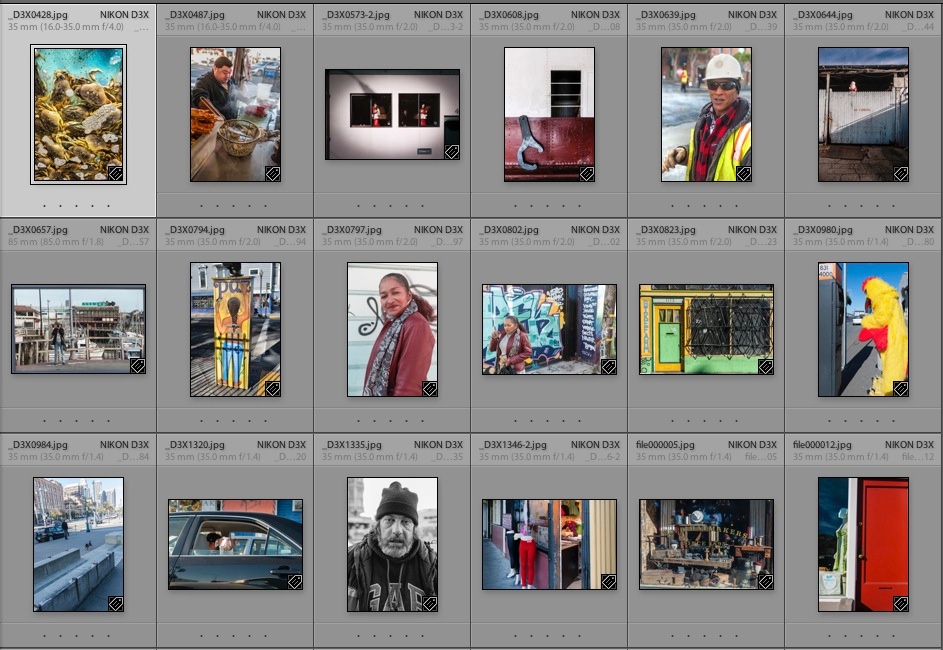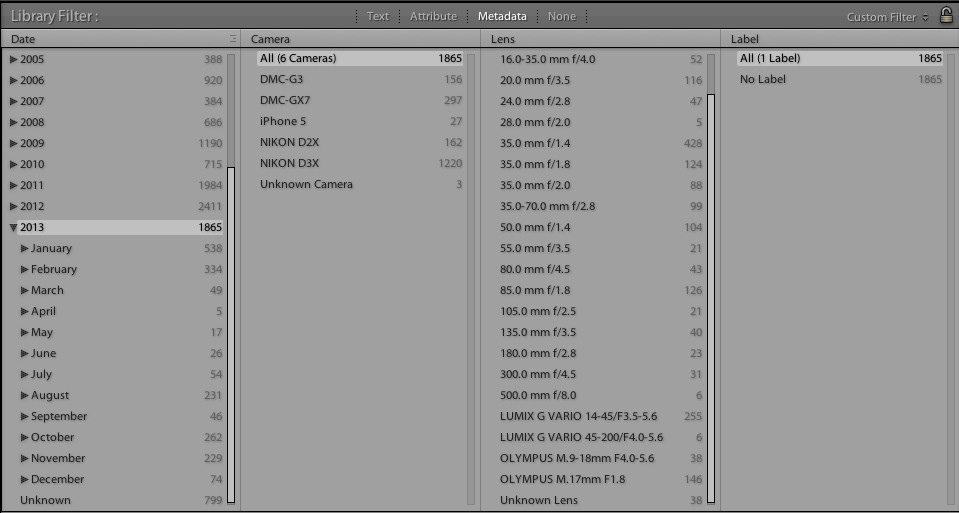A good year.
I chose 108 favorites which you can download as a slide show. That’s but three rolls of film ….
Best viewed on an iPad with GoodReader or iBooks, but as it’s a plain PDF file, anything will work. Preview works well on a Mac, in full screen mode. The file is 19MB.
Touch or click the picture below. Tech data appear below each snap. Enjoy!

Touch or click to see the slideshow.
My Lightroom database shows that I took 4,076 pictures with the Nikon D3x (full frame), 903 on the D2x (APS-C) and 1,795 on the Panasonic G3 and GX7 (MFT – 915 and 880, respectively), for a total of 6,773 snaps in the year. Plus a few on the iPhone. That’s 188 rolls of film, or 3.6 rolls a week.
Here are the post-cull data:

2013 keepers.
These show that the 35mm focal length (or 17mm on MFT) remains dominant in my way of seeing, and that the ‘keeper’ rate is 28%. I have never been a machine-gun shooter, having grown up with film whose cost was high and availability limited.
A note on the snaps:
Looking over these images, I’m struck by a couple of things. The dates of my images suggest that I make some sort of effort to get out and push the button just about every week of the year. Given my belief that vision is a muscular function like any other, and hence liable to atrophy if not exercised, it only makes sense to keep one’s eye in by regular practice. Maybe there are photographers out there who can leave gear alone for a few months, pick up a camera and immediately rate an invitation to join Magnum Photos once the results are in. I am not one of those. Bang away surely and steadily and it works for me. It’s also the most perfect therapy.
How about hardware? Let’s be honest here. Most of these images could have been made just as well with any half decent camera, film or digital, made in the past 75 years or so. Modern gear assures you of more consistent results – exposure, focus, absence of shake, ability to make huge prints and so on – it’s true, but in no way is it a necessity. The greatest benefit, I find, of the increasing sophistication of modern hardware is that the number of brain cycles the snapper needs to allocate to the technical side is fewer than ever. Thus my search for perfect street snapping gear has, as its primary goal, the reduction in this metric, meaning more cycles can be devoted to seeing and catching the moment. As I write this, my ‘invisible camera’ takes the form of the Panasonic GX7, and none other I have used puts fewer obstacles between brain and eye. While there are many lenses available I find that just one, one with a 35mm FFE, does most of what I want or need. Neither camera or lens will put you in the poor house, verging on ‘disposable cheap’.
Will the ‘dream snapper’ be better, faster and cheaper a year or two hence? Of course. But I cannot help thinking that the law of diminishing returns is very much in play given the current state of the art.
Let me put this in context from the perspective of one steeped in the use of film, before the digital era.
The Leica of 1923, the originator of mass 35mm photography hardware, was not much different from the Leica of 2003, the last film body made by the factory. (Still available for ‘artists’ in denial). Leica is a good measuring stick as it covers the whole era of ‘miniature’ photography, through the present. By 2003, lenses were better thanks to newer glass and anti-reflection coatings but by far the greatest improvements in image quality resulted not from the hardware but from the software, in this case film. Kodak pretty much perfected color film when it introduced Kodachrome just before WW2 and enhancements were modest thereafter. (In the movies, Technicolor was perfected by 1932 and has yet to be improved on). The technology was very much at the point of diminishing returns by 1939. So, for discussion’s sake, let’s estimate that 35mm film took 20 years or so to get to the point where the curve of quality vs. time started flattening quickly.
With digital, the process was much the same, if a bit faster. While Kodak may have made a functioning digital sensor in 1975, the first mass market digital cameras came to market around 1995 at considerable cost and modest image quality. By the time the Canon 5D was introduced in 2005, the first affordable FF DSLR, the quality increase curve started flattening very fast as the latest digital sensors redefined the state of the art. In contrast to the film era, it was hardware which flattened the curve, not software. Prints of any realistic size could be had from the images produced by this hardware, those images made by just about anyone, certainly a larger percentage of the population than the last days of film. A mere 10 years from mass production to near perfection, digital has almost completely killed any need for photojournalists. You can bet someone will be there when the next disaster occurs and that he will have a camera.
The technical complexities of making pictures have never been a lesser obstacle or more easily conquered, and the curve of improvement in hardware is beginning to flat line fast.
Miniaturization is also seeing the demise of a couple of hardware niches. First, the ubiquitous smartphone, always with the user, is obsoleting the point-and-shoot camera. If the image can be displayed on a phone, tablet or TV display, it’s good enough for most snappers. Second, the flapping mirror DSLR with a hunk of glass pentaprism for a finder is in its last innings. If you think that framing rates and focus speed will not be shortly superseded by mirrorless bodies a fraction of the size and weight of the pro behemoths from Canon and Nikon, and if you believe that optical finders will never be improved on by EVFs, you also probably still think the 1980 twin floppy IBM PC is the best there ever was. I expect the two majors to roll out pro-grade mirrorless bodies within a year or two at most. They may be slow moving bureaucracies, but they can read and understand sales data. Sony may have led the way here with their FF EVF A7/A7r bodies, but the pro who needs to be taken seriously at Vogue’s studios or on the gridiron is not about to show up with a camera emblazoned with the logo of a failing TV manufacturer, no matter how good the hardware.
There has never been a better or cheaper time to be a photographer.